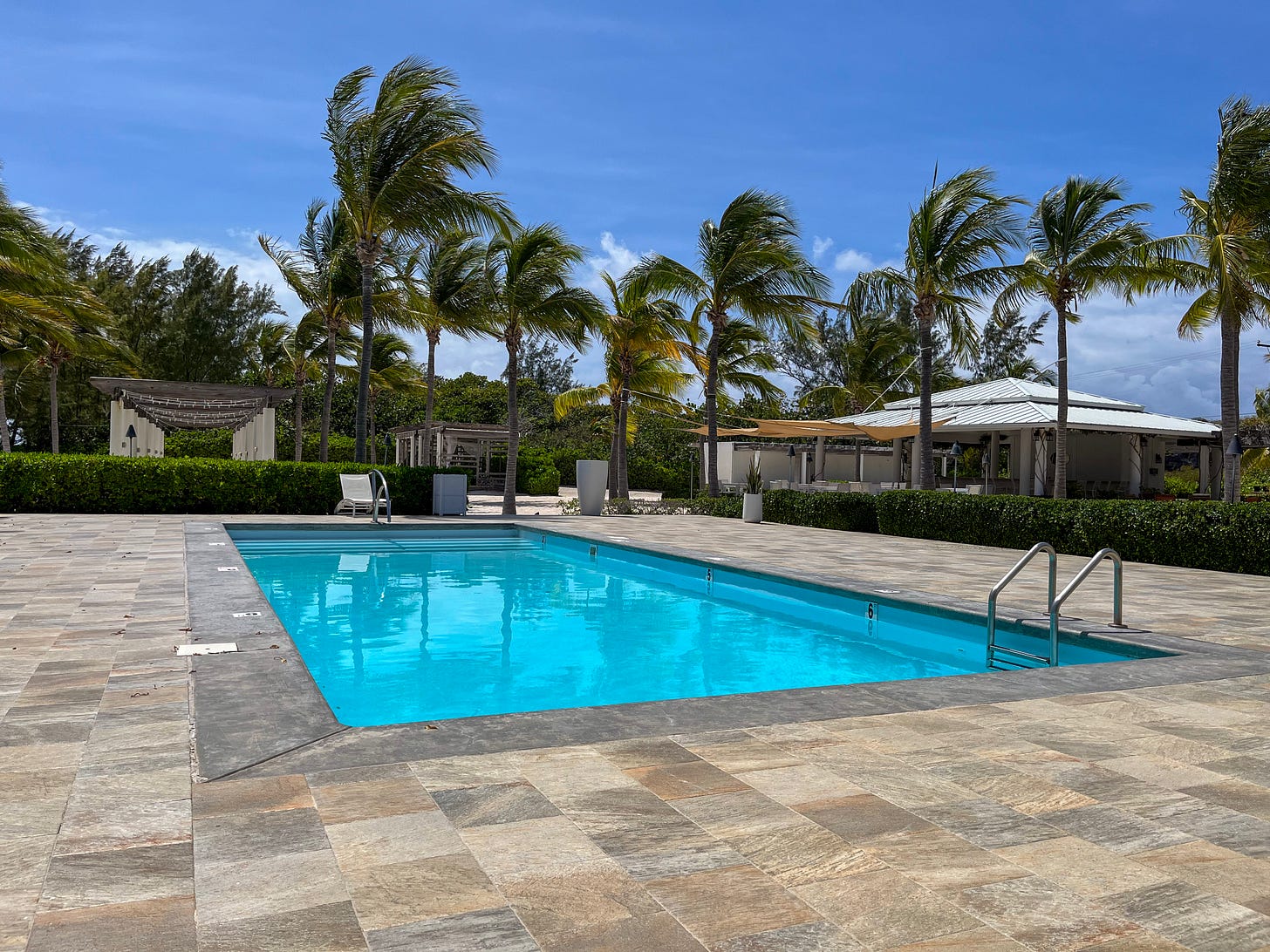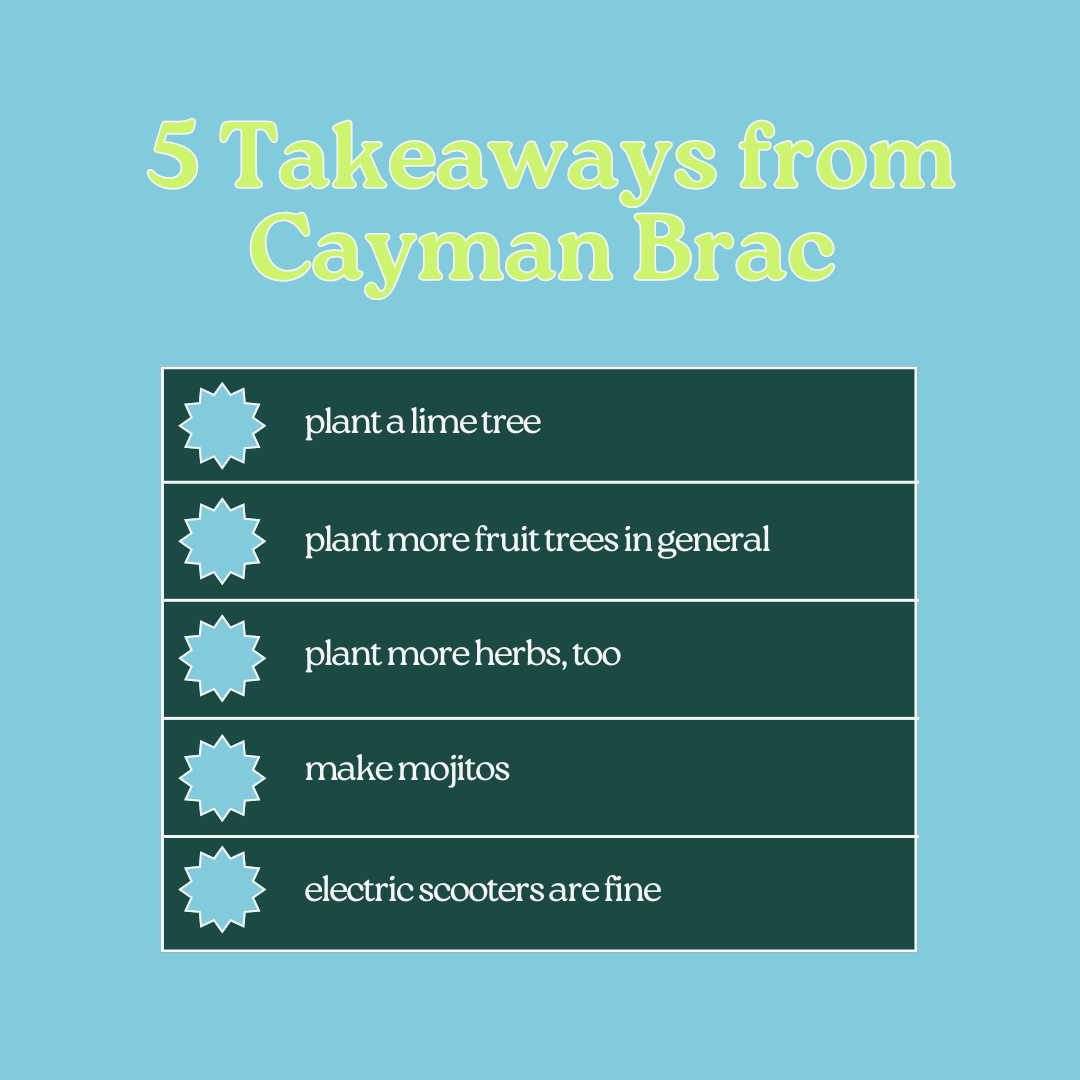Notes From A Smaller Island #2
About Cayman Brac

Visiting Cayman Brac is like visiting your own private island. Our driver from the airport said that approximately 2,000 people live on the small island, which is located about 100 miles northeast of Grand Cayman. Where exactly on The Brac, as it’s known locally, these 2,000 people are, I cannot say.
We had a beautiful stretch of beach all to ourselves on our first and second days. There was no sign of human life in any direction down the beach, as far as the eye can see. No one in the water. No one sunbathing. No one collecting shells or sea glass, except for Sarah of course, and she came away with quite a bounty of the latter. She walked her daily mile up and down the beach and confirmed it: There was not a soul to be found.
What The Brac does have, however, and this is in contrast to Grand Cayman, is a bit of elevation. A prominent spine of land dissects the island, running east to west (or west to east, if you prefer) lengthwise down the island, separating Cayman Brac into two distinct coasts — the north side and the south side. This spine is known as “The Bluff” and is a dramatic shear wall that rises more than a hundred feet up from the flat coastal plain below. It is unique in characteristic too, as it appears to be the remnants of an ancient coral reef. There are caves, home to bats, and depressions, home to iguanas, throughout the irregularly-surfaced bluff. It serves as a safe space for human inhabitants, too, when the need arises to flee from hurricanes.
If the water on one side of Cayman Brac — north or south — is rough, the water on the other side is calm. This according to Amar, who greeted us warmly at the Cayman Brac airport — the cutest in the world, for my money — upon our arrival. He gave us a quick tour of our accommodations at Le Soleil d’Or and later shared his personal journey from India with us, which took him from his birthplace to the Middle East until finally landing in the Cayman Islands where, he said, he felt like he could finally breathe. I understand this as someone still seeking oxygen myself.
Le Soleil d’Or, by the way, is a wonderful respite from the hustle and bustle of life in the States. It is an easy place to breathe, a garden oasis on this (nearly) deserted island. Le Soleil sits on 20 acres and includes a full working farm with loads of vegetables, fruit trees, and herbs. There are a few permanent residents here: Iguanas that lounge freely on the property, including poolside, and a wide variety of birds, most notably the active Bananaquit. How there are any fruits and veggies left for the humans after the iguanas and birds procure their daily rations is beyond me.

Amar showed us Le Soleil’s exclusive transportation options, should we decide to venture off the property. Which is entirely unnecessary, by the way, unless you are a sea creature in need of water for breathing. That is to say that Le Soleil has everything a land dweller could possibly want on its luxurious site — food, drink, a pool, gardens, and comfortable nooks for napping and reading. So of course, Sarah being kin to fish, we hastened from the resort early on our first full day, riding a pair of electric scooters toward the nearest body of salt water.
Now, I was skeptical of this mode of transportation after a short but trying attempt on a pair of Bird scooters on Grand Cayman just a few nights prior, and this ride started ominously enough. The scooters are not powerful enough to ascend The Bluff on their own, much less weighed down by an average adult-sized human. Hence we were forced to push them up a steep incline to the top of The Bluff.
Beyond that effort, though, the scooters ended up being a decidedly good way to move about the small island — it’s only 13 miles long — with the ability to visit the north or south shores given a little bit of inconvenience, or workout, if you rather. We visited the north on a day the south was rough and confirmed Amar’s oceanographic intelligence.
The snorkeling at Hand Cuff Reef, on the north side, was good, with easy access to the water via a ladder into a small port across the street from Pioneer Bakery, which was, sadly, closed for the day. This snorkeling spot was about a mile down from Rebecca’s Beach, where we made a futile attempt to snorkel on behalf of the hundreds, if not thousands, of spiky sea urchins in every nook and cranny of rock in the shallow water. It was too risky an entry even for Sarah, the mermaid herself, so we safely entered the emerald depths surrounding The Brac from the aforementioned harbor of Hand Cuff Reef, and enjoyed a delightful swim.
Afterward, we enjoyed a friendly chat with three locals, confirming that people do, indeed, live here after all. They seemed to be enjoying the shade, the breeze, and the peacefulness of their own private island, too.
FOOD, DRINK, STAY
Le Soleil d’Or (seriously, you can spend all of your time here if you want, it’s wonderful)
Note: This is part two of a two-part series about a trip to the Cayman Islands (read Part I here). The title of this series is in reference to the book Notes from a Small Island by the irreverent Bill Bryson, which I am reading at present. If the writing style of these posts seems a little different, it is because I am easily influenced. Blame Bill if it’s not your cup of tea!




